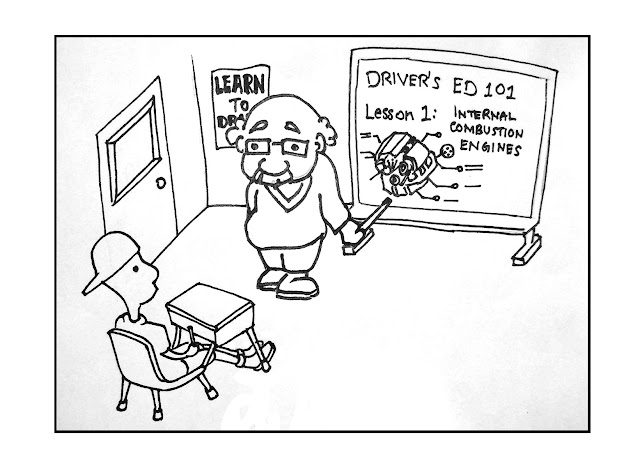Learning math should be more like learning how to drive a car
I can’t take credit for this analogy. I first heard it in a
fantastic TED talk from Conrad Wolfram on Teaching Kids Real Math with Computers.
Since watching that talk 8 years ago, I’ve spent a lot of time thinking about
the message and analogy.
I’ve drawn a comic here to illustrate a silly scenario.
I’ve drawn a comic here to illustrate a silly scenario.
When first learning how to drive, we obviously wouldn’t focus on how internal combustion engines work. The basics of learning how to drive include getting to know what each of the controls does. What it feels like when pressure is applied to the gas and brake pedals. How much the steering wheel needs to rotate to do a right angle turn. These can only be learned and understood through the act of driving. Of course there are numerous rules of the road and signs to learn about; but those also come with a clear purpose.
Why then does it not
appear silly that we approach learning mathematics by focusing on the inner
workings of how the ‘engine’ works? The inner workings are important and
valuable, but they do not need to be a pre-requisite to being able to think
about the math concepts.
Take Calculus for example, a large part of our math
education builds up the skills from K-12 to do this topic. However, students
never get to actually think about Calculus or even know what it is by the time
they graduate high school. They spend time building up and practicing arithmetic
operations, solving equations, combining like terms, determining slopes of
lines, and so on. Each of these skills on their own can certainly be valuable
and can tap into rich mathematical concepts; but unfortunately, they can also be learned as
requisite procedural skills that are seen as necessary before moving onto ‘harder’
concepts.
Students often see Calculus as a mysterious topic that they
will never be able to reach or understand.
I tried an experiment with my 6 year old daughter. I showed her this picture and asked her what shape it was:
She didn’t know the name of it. I asked her if it was a
circle and that she knew was a firm “no!”
At first she said “no”… but then she said “but it’s a better
circle than the first one.” When I asked her why, she replied that “it has more
sides and is more round”.
She exclaimed “There! That’s the best circle!”
Boom. My six year old daughter was thinking about the ideas of Calculus. Calculus is a branch of
mathematics that is partly built on the idea of many, many sides that get
really, really small. She was able to imagine shapes with more sides and how
that would look as a shape; at the same time imagining what would need to
happen to the length of those sides.
She doesn’t know what an equation is, and certainly doesn’t
know how to differentiate a function. Yet, the thinking came naturally to her because
she had a visual as an anchor. Even if she didn’t have the terminology to
communicate mathematically, she was trying to use words that meant something to
her.
Do kids really need to learn all the way up to how to
differentiate functions before we introduce them to the beautiful ideas of
Calculus? Would we ask someone to learn how to build an engine before they were
allowed to drive?
Being able to drive a car has become a large part of
functioning in today’s society; it is a skill that the majority of adults have
learned. We give the message that math is just as important since we make
everyone learn it. In his TED talk, Conrad Wolfram says that there is nothing
wrong with engineering and building engines, if that is your passion. It is
specialized though, and you wouldn’t ask everyone to do it. Just as in math,
should we make everyone learn it and then teach it in a way that is
specialized?
Or can we get more students using and ‘driving’ math and
seeing the relevance and beauty in it. Perhaps that would even result in getting
more people passionate about diving deeper into the “inner workings”.







A great discussion topic. Bring in the beauty. I love exploring the beauty of math via computer simulations. Frees me of the limitations of my fine motor skill accuracy and time. Here is an article you may find of interest: http://theconversation.com/mathematics-is-beautiful-no-really-72921
ReplyDeleteTechnology is really opening the possibilities with visuals and animations that are powerful models that were not previously possible. Thanks for sharing the article!
DeleteYour blog post reminds me of Anna Sfard's paper on the dual nature of ideas, that they are simultaneously and inseparably conceptual and procedural. One example she gives is that a circle conceptually are points that are equidistant from a center, while procedurally a circle is created by sticking one end of the compass and twirling the pencil end around.
ReplyDeleteHere's a link to the article... https://link.springer.com/article/10.1007/BF00302715